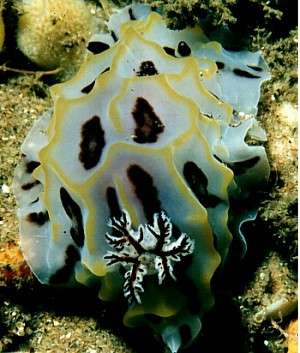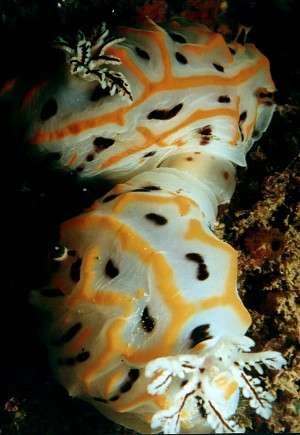Colour variation in Halgerda dichromis
November 24, 1999
From: Valda Fraser

Dear Bill
To answer your question about colour variation, to date all specimens of Halgerda dichromis I have seen have seemed very similar in colour. Over the weekend, however, I saw a specimen that has made me stop to think. This one has no black spots. Are they just missing, or is this another kind of Halgerda?
I also wonder if it is possible for this nudibranch to adapt its colour to the immediate environment - like a chameleon. I ask this as I have noticed that when the animal is on sand it is less vividly coloured. Refer to the two lower photos for comparison.
You will note that the pair in the lower right photo are mating.
Locality: South Coast KwaZulu-Natal, SOUTH AFRICA. Scottburgh / near Port Shepstone.
UPPER RIGHT: 60mm long, 24m depth,
LOWER LEFT: 55m long, 36m depth,
LOWER RIGHT: 50mm long, 20m depth.
Date: October - November 1999
Regards
Valda Fraser
iti04937@mweb.co.za


Dear Valda,
This is certainly the sort of colour variation I was hoping for. The orange lines in the upper photo look very like those illustrated by Fahey & Gosliner, although your specimen lacks any black lines. The other two photos, and your first photo seem to suggest the three are the same species.
Very few sea slugs have been reported to show any chameleon-like ability to change colour although some can gradually change colour if their colour is derived from food pigmentation. The difference in the yellow/orange colour may be genetic or it is possible that it could be a food-based pigment from their sponge food. If the sand-dwelling ones are feeding on a less intensely coloured sponge than the rock dwelling ones then I guess a locality related colour difference could develop. But I have no evidence to back that up.
The other possibility is that the yellowish animal (lower left) is another species. It definitely has more complete ridges than the orange lined animals, looking more like Halgerda formosa in shape, if not in colour.
All very interesting,
Best wishes,
Bill Rudman.
Related messages
-
Colour forms of Halgerda dichromis mating
From: Valda Fraser, March 31, 2009 -
Halgerda toliara? from Madagascar
From: Leif Abrell, January 20, 2001 -
Halgerda dichromis? from South Africa
From: Valda Fraser, August 8, 2000 -
A variety of Halgerda dichromis?
From: Valda Fraser, July 10, 2000 -
Halgerda dichromis from South Africa
From: Valda Fraser, March 12, 2000 -
Re: Halgerda dichromis
From: Valda Fraser, December 1, 1999 -
Halgerda dichromis? from South Africa
From: Valda Fraser, November 19, 1999
